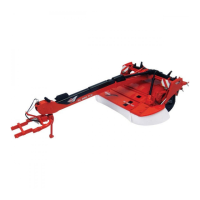What to do if the rotor is no longer driven on my KUHN FC3160TCD Farm Equipment?
- DDestiny MaySep 6, 2025
If the rotor is no longer driven, the safety system shear bolt may have sheared. Replace the screw. (See maintenance and storage chapter)

What to do if the rotor is no longer driven on my KUHN FC3160TCD Farm Equipment?
If the rotor is no longer driven, the safety system shear bolt may have sheared. Replace the screw. (See maintenance and storage chapter)
How to fix uneven stubble with KUHN Lawn Mower?
If your KUHN Lawn Mower leaves uneven stubble, several factors could be the cause. The knives might be dull or broken, in which case you should replace them. Also, ensure the knives are installed correctly with the arrow on the knife's upper face pointing in the disc's direction of rotation. Excessive ground speed, incorrect cutting height, or incorrect mowing unit floatation can also lead to this issue; reduce ground speed, adjust the cutting height, or adjust the mowing unit ground pressure accordingly. If you're dealing with tangled and down crops, try reducing the cutting height and increasing the mowing unit ground pressure.
Why is my KUHN Lawn Mower rotor finger rattling?
If your KUHN Lawn Mower's rotor fingers are rattling, it could be due to insufficient rotor speed. To resolve this, select the rabbit position to achieve a rotor speed of 1000 min-1. Another possible cause is that the conditioning hood is too closed; try positioning the rotor conditioning hood further away. Excessive ground speed can also contribute to this issue, so reducing your ground speed may help.
| Brand | KUHN |
|---|---|
| Model | FC3160TCD |
| Category | Farm Equipment |
| Language | English |
Diagrams of front/rear views and information on the model identification plate.
List of optional equipment available for the mower conditioner.
Explanation of symbols and core safety guidelines for operating the machine.
Precautions for coupling, PTO shaft, hydraulics, driving, and general operation.
Safety measures required during maintenance, repair, and troubleshooting.
Location/description of safety decals and road transport safety equipment.
Information on road safety equipment and compliance with traffic regulations.
Overview of machine parts and definitions of technical terms.
Detailed technical data, dimensions, and performance specifications.
List of required equipment and measured sound levels during operation.
Identification of control elements and supplied tools for machine setup.
Step-by-step guide for attaching and detaching the machine from the tractor.
Instructions for installing and adjusting the primary and intermediate PTO shafts.
Procedures for adjusting machine links, frame height, and check chains.
Guidelines for placing and securing the machine in transport configuration.
Ensuring the machine complies with road transport laws and regulations.
Procedure to transition the machine from transport to its operational working state.
Adjustments for cutting height, ground pressure, rotor speed, and conditioning.
Adjusting swath width and operating the wide spreading system.
General operation guidelines and adapting forward speed to field conditions.
Description and purpose of optional check chains and lifters.
Details on optional swath shields and the 1 3/8 - 21 spline yoke.
Information on optional raised skid shoes and SMV signs for height adjustment and safety.
Schedule for routine maintenance tasks based on usage hours or time.
Instructions for thorough cleaning of the mower conditioner.
Detailed procedures for lubricating PTO shafts, joints, and greasing points.
Procedures for draining and refilling oil in cutterbars and gearboxes.
Procedures for inspecting and replacing knives and their fastening components.
Instructions for replacing mower discs and spring plates.
Procedures for maintaining and replacing components of the rotor safety system.
Tasks for storing the machine at the end and preparing it at the start of each season.